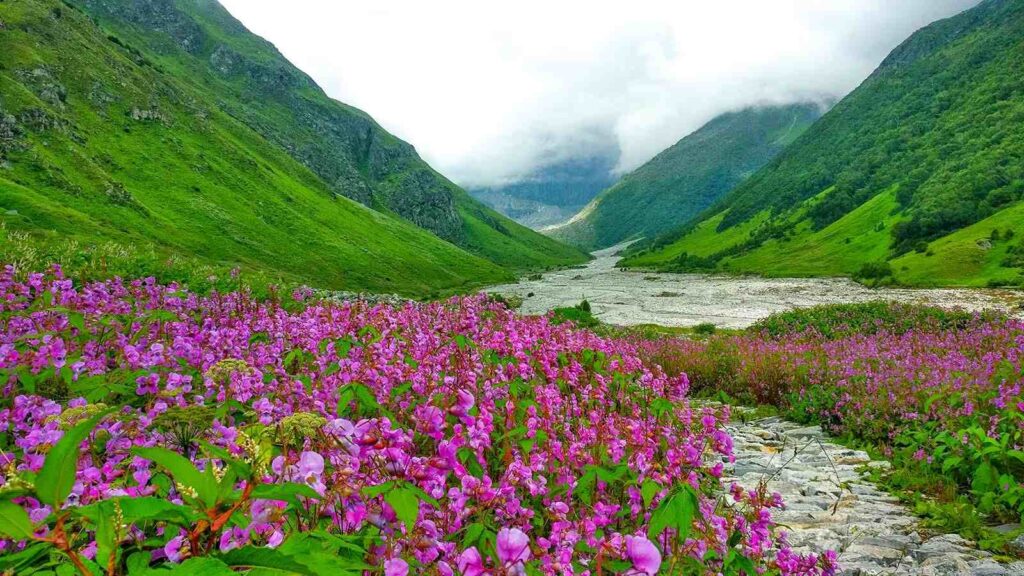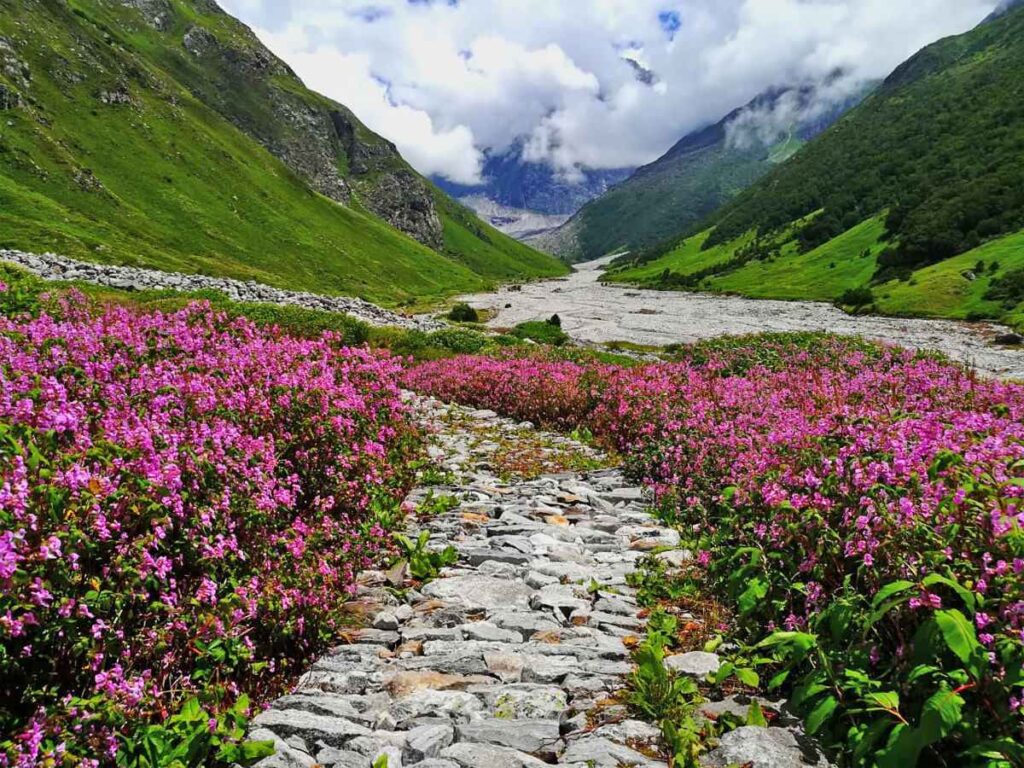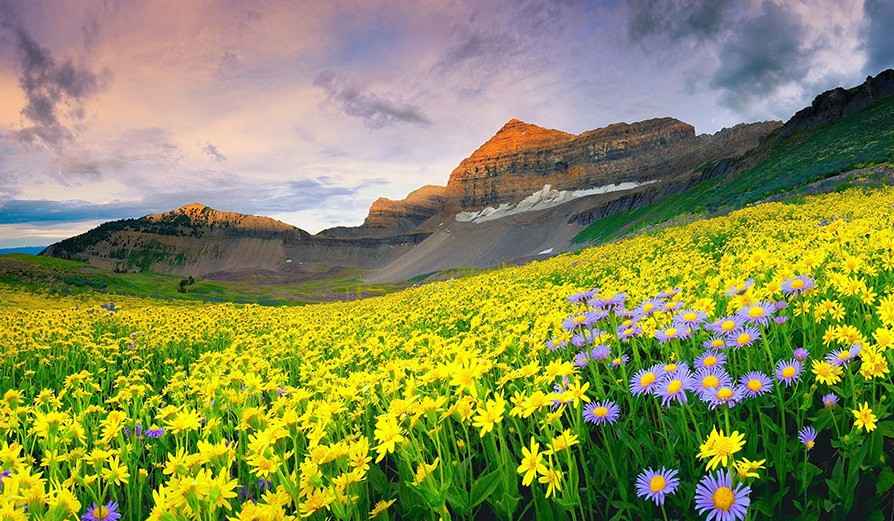Valley of Flowers

Hemkund Sahib, otherwise called Gurudwara Sri Hemkund Sahib Ji, is a Sikh journey site situated in the Chamoli locale of Uttarakhand, India. It is in the Himalayas and is about 4,632 meters (15,197 feet) above sea level. Hemkund Sahib is highly revered in Sikhism and is visited annually by thousands of devotees.
The following are important details about Hemkund Sahib:
Spirituality’s Importance: Sikhs revere Hemkund Sahib because it is believed that Guru Gobind Singh, the tenth Sikh Guru, meditated there in his previous life. It is also linked to Guru Nanak Dev, the founder of the Sikh religion, who is said to have visited the area. Hemkund Sahib’s gurudwara, or Sikh temple, is dedicated to Guru Gobind Singh.Beauty in Nature: The pilgrimage site is tucked away in the midst of incredible natural beauty. It is surrounded by snow-capped peaks, green meadows, and the crystal-clear Hemkund Lake, making it a peaceful and picturesque setting. During the summer, when numerous alpine flowers, including the rare Brahma Kamal, bloom, the region is also renowned for its vibrant floral diversity.
Walking Trail: Hemkund Sahib is open by means of a journeying course that beginnings from the town of Govindghat. The trek has a steep ascent and is about 19 kilometers (11.8 miles) long. The trek can be completed in anywhere from six to eight hours, depending on individual fitness levels. Those who would rather not walk are able to hire horses and palanquins.
Lake Hemkund: Near the gurudwara is the crystal-clear Hemkund Lake. Sikhs regard it as sacred and believe it has healing properties. As a form of spiritual practice and purification, devotees frequently take a dip in the lake’s freezing water.
Season of Sikh Pilgrimage: Due to its high elevation and harsh weather, devotees can only visit Hemkund Sahib for a limited time. The pilgrimage season typically begins in May or June and lasts until October, with the busiest months being July and August. Due to the heavy snowfall during the winter, the gurudwara remains closed.Facilities and Accommodations: Pilgrims have access to lodging and langar (community kitchen) facilities at the gurudwara complex at Hemkund Sahib. Langar is a Sikh custom that provides free meals to all visitors, regardless of their social or religious upbringing.
Sikhs and other devotees who make the difficult trek to this sacred Himalayan location are said to have a spiritually enriching experience when they visit Hemkund Sahib. It is a one-of-a-kind combination of spirituality and adventure because it combines faith, natural beauty, and solitude.
Historical Significance:
Sikh pilgrimage site Hemkund Sahib is in the Indian state of Uttarakhand. For Sikhs, it has significant historical and religious significance. The following are some important aspects of Hemkund Sahib’s historical significance:
1. Gobind Singh Guru: Hemkund Sahib has a strong connection to Guru Gobind Singh, the tenth and final Sikhism Guru. Guru Gobind Singh, a Sikh saint, is said to have meditated at Hemkund Sahib in his previous life. While meditating on the sacred lake’s shores, he reached enlightenment and merged with the divine. Because of this historical connection, Sikhs revere Hemkund Sahib.
2. Dasam Award: The compilation of the Dasam Granth, a sacred Sikhism text, is also linked to Hemkund Sahib. It is believed that Guru Gobind Singh wrote a significant portion of this text while residing near Hemkund Sahib. Sikhs recite the Dasam Granth, which is regarded as an essential religious text, during religious ceremonies and prayers.
3. Chamkaur Sahib Battle: The Battle of Chamkaur Sahib is another historical event associated with Hemkund Sahib. During a conflict with the Mughal Empire in 1704, Guru Gobind Singh and a small group of his followers sought safety in the Chamkaur Sahib fortress. Sahibzada Ajit Singh and Sahibzada Jujhar Singh, the Guru’s two older sons, bravely participated in this battle. Despite the Sikhs’ defeat, the battle is a reminder of their bravery and selflessness. Numerous Sikhs accept that Master Gobind Singh’s contemplation and illumination at Hemkund Sahib gave him profound strength during this difficult time.
4. Architecture’s Importance: The main religious structure at Hemkund Sahib, the Hemkund Sahib Gurudwara, is of architectural significance. It is in the Himalayan region and is about 4,632 meters (15,197 feet) above sea level. The Gurudwara has a white marble facade and a prominent dome in the distinctive Sikh architectural style. Every year, thousands of people make the difficult journey to reach this high-altitude shrine.
In general, Hemkund Sahib is significant in history because it was the location of Guru Gobind Singh’s spiritual journey and the creation of the Dasam Granth. During the Battle of Chamkaur Sahib, it also serves as a reminder of the bravery and perseverance of Sikhs.
Spiritual Significance:
Hemkund Sahib is a position of extraordinary otherworldly importance for Sikhs and holds an exceptional spot in their strict convictions and practices. An overview of the spiritual significance of the Hemkund Sahib is as follows:
Relevance in the past: Hemkund Sahib has a strong connection to Guru Gobind Singh, the tenth Sikh Guru. Guru Gobind Singh meditated at the high-altitude lake that is now known as Hemkund Sahib in his previous incarnation, according to Sikh tradition. At this sacred location, it is believed that the Guru attained spiritual enlightenment.
Relationship to Sikhism: Sikhs consider Hemkund Sahib to be one of their most significant places of pilgrimage. It is believed to be the location where Guru Gobind Singh underwent intense austere practices and meditation, which ultimately resulted in his spiritual transformation. Sikhs believe that the location inspires them to strive for spiritual development and selfless service by bringing to mind the Guru’s teachings.
Natural Beauty and High Altitude: Hemkund Sahib is surrounded by breathtaking natural beauty at an elevation of approximately 4,300 meters (14,100 feet) in the Himalayas. A serene atmosphere is created by the awe-inspiring mountain landscapes and the pristine glacial lake, making it ideal for spiritual contemplation and connecting with nature.
Equality and unity: The Hemkund Sahib is a symbol of Sikhism’s fundamental beliefs, including equality and unity. It is open to people of all backgrounds, regardless of caste, religion, or social standing. All religions are welcome to participate in the Hemkund Sahib pilgrimage, which emphasizes Sikhism’s inclusive nature and fosters community unity.
Selfless Service, or Seva: In Sikhism, the practice of seva, or selfless service, is deeply ingrained. There are numerous opportunities for seva at Hemkund Sahib, with devotees volunteering to cook, clean, and assist other pilgrims. In keeping with the Sikh values of compassion and service to others, the act of seva is seen as a way to purify the mind, cultivate humility, and serve humanity.
Spiritual Purification: It is believed that Hemkund Sahib has transformative and purifying properties. The sacred lake’s icy waters are regarded as a significant act of purification, representing the purification of one’s sins and bad karma. This difficult journey is undertaken by many pilgrims in search of spiritual comfort, forgiveness, and renewal.
Sikhs view the Hemkund Sahib as a symbol of the transformative power of devotion, meditation, and selfless service, and as a result, it has a significant spiritual significance. It is a sacred location where people can connect with the divine, cultivate their spirituality, and reaffirm their adherence to Sikh principles and values.
Best Time To Visit Hemkund Sahib:
Lorem ipsum dolor sit amet, consectetur adipiscing elit. Ut elit tellus, luctus nec ullamcorper mattis, pulvinar dapibus leo.

Summertime, from May to June and September to October, is the best time to visit Hemkund Sahib. In the Indian state of Uttarakhand, Hemkund Sahib can be found at an elevation of approximately 4,633 meters (15,200 feet) above sea level.
During the summer, the temperature ranges from 10 to 25 degrees Celsius (50 to 77 degrees Fahrenheit) during the day, but it can drop significantly at night. The weather is generally pleasant. By this point, the snow usually has melted, making the hike to Hemkund Sahib easier.It is essential to keep in mind that Hemkund Sahib is in the high Himalayas, which means that the weather can be unpredictable. Before making plans for your trip, it’s best to check the forecast for the weather and the state of the roads. Additionally, since the weather can change quickly at higher altitudes, it is recommended to bring appropriate clothing with you, such as rain gear and warm layers.
Please keep in mind that my knowledge cutoff is September 2021; therefore, prior to planning your trip to Hemkund Sahib, it is always a good idea to confirm the current conditions and any travel warnings.

Trekking Adventure Hemkund Sahib
Traveling to Hemkund Sahib is a famous and bold excursion in the province of Uttarakhand, India. Hemkund Sahib is a Sikh pilgrimage site in the Himalayas at an elevation of approximately 4,632 meters (15,197 feet). It is well-known for its religious significance, serene beauty, and scenic beauty.
Govindghat, a location that is easily accessible by road from major cities like Rishikesh and Haridwar, is usually where the trek to Hemkund Sahib begins. The hike, which starts at Govindghat and is about 19 kilometers (11.8 miles) long, takes you through beautiful landscapes like lush green meadows, dense forests, and breathtaking mountain views.
The trail is well-defined, fairly steep, and ascends gradually. You’ll pass through a few small towns, waterfalls, and streams on your way. The Valley of Flowers, a UNESCO World Heritage Site on the way to Hemkund Sahib, is one of the trek’s highlights. The valley is a haven for botanists and nature lovers thanks to its vibrant and varied alpine flora.
The sparkling Hemkund Lake is surrounded by snow-capped peaks as you approach Hemkund Sahib. Sikhs use Hemkund Sahib’s gurdwara, or Sikh temple, as a place of worship and pilgrimage. It is on the lake’s shores. A Sikhism tradition is that the gurdwara has a langar, or community kitchen, where you can get a free meal.
The summer months, from June to October, are the best times to go on the Hemkund Sahib trek because the snow has melted and the trail is easier to navigate. Being well-equipped for the trek with comfortable clothing, sturdy shoes, and a backpack stocked with water, snacks, and first aid supplies are essential.
Because the high altitude can be difficult for some people, it is best to properly acclimate before going on the trek. In addition, it is suggested that you hire a local guide or join a trekking group for assistance and safety throughout the journey.
By and large, journeying to Hemkund Sahib offers an interesting mix of regular magnificence, otherworldliness, and experience, making it a critical encounter for travelers and pioneers the same.
